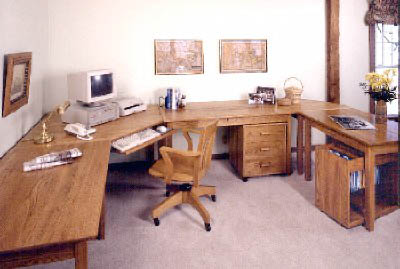
Most of us have, at one time or another, designed ourselves into a corner with a project. You add and you add and you add, and all of sudden nothing quite fits together. It’s at this point that we should all sit back for a second and take a lesson from Don Woodruff. He has a three-person furniture making business in Pittsfield, Maine called Homeworks, and he’s created a successful company building home office furniture based on one of the simplest designs imaginable: the library table.
He started with the library table for a few reasons. First, it was approachable from all sides. Second, it had a history of practical utility. Third, because it was simple, it could be easily adapted to the needs of his customers.
Take, for example, a simple desk for your home office (what Don calls a knee-hole desk). It’s essentially a big flat surface with some drawers underneath the surface and a space where you put your legs and lap. Don’s simple solution for this setup is one library table and one or two rolling file cabinets. They all match, so they look like a complete unit when combined, but they can also be rearranged and used a variety of ways. One of his early adaptations to the library table concept was to substitute a keyboard tray, in most cases, for the center drawer.
He also learned that there were two kinds of offices out there: the home office and the small office. The home office was typically just a workspace and the desks and tables would be pushed against a wall. The small office, on the other hand, was a place where people interact with clients, so the library table would be away from the wall and between those communicating. That meant it had to be adapted with modesty panels and the edges of the table needed to be softened so they didn’t create a severe environment for conversation.
The Customer is Always Right…Almost
With the library table as his design base, Don then spends some time with customers to help them design furniture for their home office. By asking a few questions, he can often help them determine what their needs are and how best to meet those requirements. “You should be able to look at what you’re doing, what your functions are, and be able to lay out an office to marry the furniture with those functions,” says Don.
And that usually means having a conversation with customers. His business philosophy is: “build a relationship and then build the furniture.” These relationships help him customize furniture for each client, but they’ve also given him some great ideas for pieces that have become part of his permanent portfolio. Don estimates that half of the furniture he regularly builds comes from ideas given to him by customers.
But that, of course, doesn’t always work. The Arts and Craft Cabinet he designed is a good example of customer input that didn’t quite pan out. Customers kept telling Don that they wanted an elegant cabinet where they could hide their computer but would fit in with their decor. And the cabinet he designed did just that. Unfortunately it didn’t sell very well. “I found out over time,” says Don, “that people come around and kick tires and talk about what they’d like to see with no intent whatsoever of purchasing something like that.”
Customer input works both ways. While the Arts and Craft Cabinet didn’t sell terribly well, the Corner Desk was an idea that’s been very successful. Don designed a prototype, but sort of left it on the shelf until a customer came along with a specific need. When he showed the client his design, it was deemed perfect, and Don began to build more of them and take them to shows. It’s been a very popular item.
Using the Internet to Communicate (Doh!)
Most e-commerce pundits and consultants tout the Internet as a great way to sell your goods directly to a national audience. Don confesses that it really hasn’t done that for him. While about 65 percent of his customers have used the Internet to find him, he doesn’t get a lot of orders right over the transom (except for his Stand-Up Desk). Instead, the Internet has helped him communicate more effectively with customers. Clients will be out surfing the Web and see something they really like…except for one or two features. Then they will contact him and tell him what they saw and what they’d like to customize. Often he will encourage customers to go out on the Net, to his site and other furniture makers’ sites, to get ideas for their home office. “If you can build a relationship with your customer, sometimes surfing can help you in terms of getting their ideas into a concept that can be communicated,” says Don.
– Bob Filipczak





